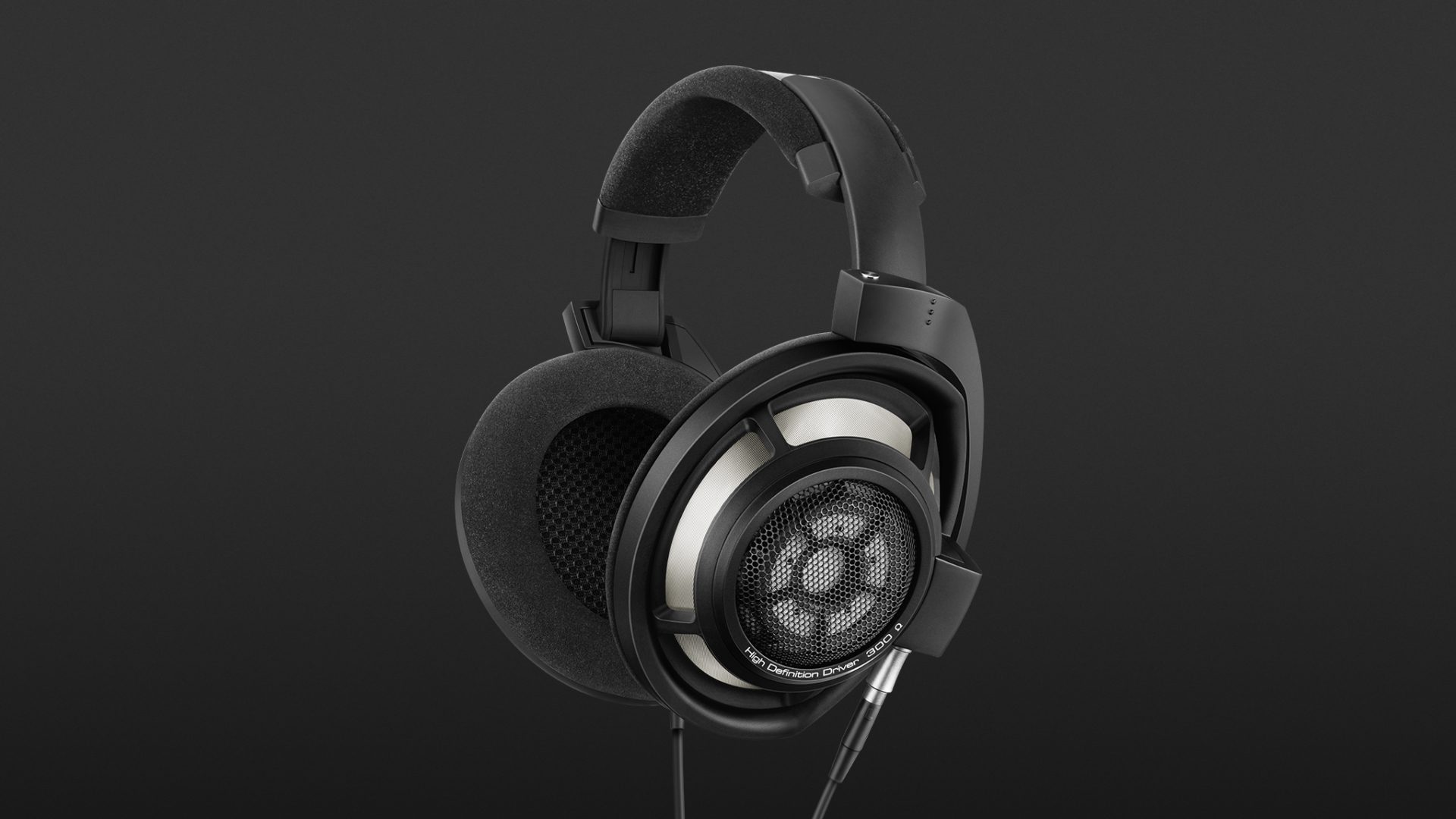If you are looking for a top-class sound experience, you should give the HD 800 S a closer look. Their resolution earns top marks in all disciplines, as do the wearing comfort and workmanship. With these qualities, the HD 800 S are not only an extraordinarily fine tool for sophisticated music enjoyment, but also a magnifying glass for professional, sound engineering work. In short: these headphones are a dream. Of course, you pay a price for this sound experience, but it seems to me to be quite reasonable in view of the performance of the competition.
With the exception of the Orpheus HE-1, the HD 800 S is the top model among Sennheiser’s open headphones. The successor to the HD 800 from 2009 is available both in the regular version tested here in black and in a technically identical Anniversary Edition in stylish matt gold which is limited to 750 units – and available for the same price.
The open construction relies on dynamic so-called ring resonators, which, with a diameter of 56 mm, are larger than in all other Sennheiser headphones. The overall workmanship is exceptionally high-quality and robust enough for daily use. The length-adjustable headband with laser engraving and cushioned element is made of metal and plastic and has replaceable padding. The large ear cups have a small swivel range and are fitted with a comfortable microfibre padding that can also be replaced. The outer insulation is comfortable and reduces vibrations such as footfalls that impact sound.
Other interesting details are hidden in the seemingly straightforward design. For example, the stainless-steel enclosed transducers are slightly angled in the ear cups, which is supposed to have advantages for spatial hearing and the naturalness of the reproduction. Likewise, they use a proprietary absorption technology which is supposed to reduce masking effects caused by low frequencies in the high-frequency range and thus improve the precision of reproduction. At the same time, it should be noted that this barrage of components does not have a negative impact on weight thanks to a modern choice of materials, as the HD 800 S weighs just 330 grams.
Compared to the successor of the HD 800, which is also outstanding, not only the colour of the housing but also the technical construction has been optimised. The extra-large transducers used are identical to the predecessor, but have been given additional damping silk to smooth out the upper frequency response and a Helmholtz resonator, which is also effective in the high-frequency range. The balanced Pentaconn cable is now also included in the scope of delivery, which ultimately also results in a price increase of the HD 800 S. Like its predecessor, it is completely handmade in the factory in Wedemark, Lower Saxony, including exact matching of the drivers and strict quality control.
In practice
These headphones have two explicit goals: to provide outstanding sound reproduction for the audiophile music lover and to provide a reliable working tool for professional sound engineers when assessing and working with audio material. As an open design, the HD 800 S are not designed for either sound recording or mobile use by musicians, but they find their home when used with a high-quality headphone amplifier or in an audio control room. In our case, the RME ADI-2 Pro FS and the SPL Phonitor se came into play, and indeed distinguished themselves in terms of sound quality from the headphone amplifier of my Focusrite Clarett 4Pre audio interface.
The functionality is precisely tailored to the aforementioned tasks. The HD 800 S works with a high-quality 3-metre connection cable. This is routed to the ear cups on each side and is securely anchored with interlocking plugs. The first of the two cables supplied is unbalanced and ends in a gold-plated 6.3 mm jack plug. The second cable is a balanced version with a five-pin 4.4 mm jack plug (Pentaconn), which can be used with the same brand’s HDV 820. There is also the option to purchase a balanced cable with an XLR 4 plug, which at 199 Euros is not necessarily cheap.
The wearing comfort earns top marks, even during long listening sessions. The ear cups enclose the ears generously with only slight pressure. Their position is nevertheless securely maintained, although it may be assumed that the HD 800 S is generally worn in a stationary position, in a professional environment, for example in front of a mixing console, so one does certainly moves back and forth.
Sound
The HD 800 S are designed to meet the highest demands, which is certainly justified given the sales price. The result is indeed remarkable and truly excellent in the audiophile sense. With an unbalanced connection, however, the headphones are not particularly loud. As mentioned, the test unit benefits from a high-quality headphone amplifier, which is why we can assume sufficient and distortion-free performance. By the way, if you use a balanced connection, the level is doubled.
The HD 800 S offers breath-taking detail resolution that encompasses the entire frequency spectrum, the dynamics, the stereo panorama and even spatial sound. All aspects are clearly audible and assessable, as the headphones have a general tendency to be analytical rather than warmly tuned.
The countless details and transient information results in a very finely differentiated, stable and broad stereo panorama with precisely comprehensible dynamics (Yello: Arthur Spark). Even more remarkable for a pair of headphones, I found the finely resolved spatial representation, which reproduces the room and reverb effects to a highly recognisable degree – a characteristic rarely found in headphones in this form. As expected, the typical speaker depth is not achieved.
The ability to achieve fine gradation in the temporal dimension is equally exciting: the HD 800 S are able to reveal the finest time gradations, such as those found in doubled vocals.
In the treble range, Sennheiser’s reference is wonderfully open and endowed with a silvery airiness that one only encounters in higher price ranges. However, this is not only pleasing but accurately detects any shift into harshness in a mix. The upper bite of a snare drum is not lost, but these headphones do not overshoot the mark either.
Speaking of voices: these are characterised by excellent intelligibility so the HD 800 S are also an excellent choice for voice recordings and editing work. I would describe the midrange in general as lean and also open. The test unit was fabulous with voices but also delivered a full-bodied richness and pressure in rock productions that doesn’t sound thin. I was able to dive analytically into the complex sound structures of a mix and even into the distortion itself with remarkable depth, for example with Glenn Hughes’ “This is my town”. Basically, the HD 800 S are not limited to any genre. Orchestral works or those that rely primarily on acoustic instruments are reproduced just as perfectly as jazz, rock, pop and electronic music. The countless small details always come together as you would hope, to form a large whole that can be both enjoyed and really listened to. Quite often, you can discover nuances of all kinds that remained hidden on simpler monitor systems. For example, the eerie buzz of the low strings in Tori Amos’ “Star Whisperer” is something I’ve never heard so clearly before.
In the bass range, the HD 800 S are less spectacular than most of their competitors and rather sober or slim. Nevertheless, the bass reproduction is defined, tight and confident in tonality and dynamics, right down to the lowest frequencies. The fact that this area does not come to the fore, I put down to them being deliberately tuned to favour neutrality. Correspondingly, I had to assume that competitors were usually too “thick” to compensate for the lack of structure-borne sound at low frequencies. In the audiophile sense, Sennheiser is taking the right approach here. From an audio-technical point of view, however, one may be in two minds about this: I would not use the bass range of the HD 800 S as the sole, universally valid basis for a mix.
Finally, a brief comparison within the product family. Unfortunately, the predecessor was not available to me for a test. According to the manufacturer, however, the current version sounds more spacious and natural than its predecessor. The HD 820 has a similar sound but is aimed at customers who explicitly want a closed, audiophile system. In my opinion, the HD 800 S has slight advantages in terms of detail and resolution. It sounds airier, more defined in the bass and fuller in the mid-range. Despite the price difference, which results from the more complex production of the HD 820, I do not find this unusual, because the HD 820 is a closed construction.
The second headphones we used for comparison were the Sennheiser HD 660 S. Compared to these, the HD 800 S perform in a considerably higher class. The fit of the HD 600 S was tighter. They play louder and quite impressively, but had noticeably less spatial depth and detail resolution, sounded less airy and were clearly more prominent in the bass range.
Technical specifications
- Ear couplingOver-ear
- Typeopen
- Transducer principledynamic
- Frequency response (headphones)4 - 51.000 Hz
- Impedance300 ohms
- Weight without cable330 g
- Cable length300 cm
What's in the box
- Cable with 6.35 mm jack plug
- Balanced cable with 4.4 mm jack plug
- Microfibre cleaning cloth
- USB stick









































